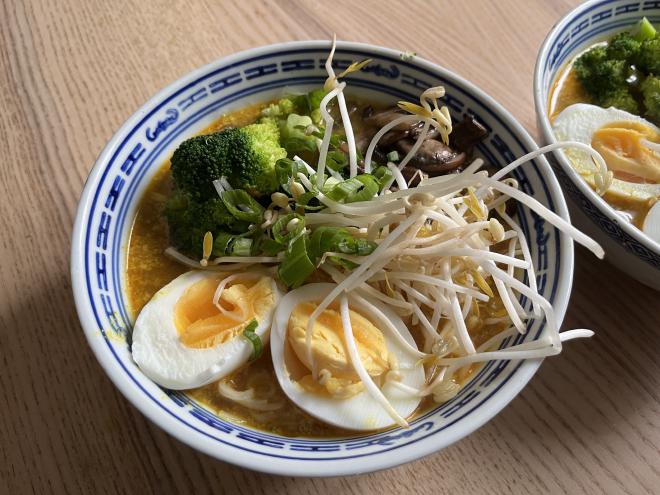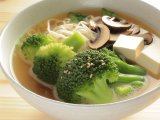Wagamama Firecracker Ramen inspired by AlfieCooks
Table of Contents
Jump to Recipe
Jump to Carbon Footprint

Last year, we tried out almost every ramen restaurant in the city and after a while we started cooking ramen at home too. After a few attempts, we settled on a basic recipe based on the “Firecracker Ramen” by “alfiecooks_”, which you can see on TikTok or YouTube, among others. The broth has a very good spiciness and pungency and a great mouthfeel.
You can of course be creative with the toppings. We use a vegetarian combination here, including boiled egg, but classic recipes often include braised pork belly or fish cake.
Apart from the egg, the recipe is vegan. When calculating the carbon footprint, you can see what impact the eggs have compared to the other ingredients.
Recipe #
Firecracker ramen, inspired by Alfie Cooks
60 minutes
2 portions
Ingredients #
For the broth #
- 2 cloves garlic
- about 10 g ginger
- 1/2 red chili pepper
- 1/2 bunch spring onions (keep the green for garnishing)
- 2 teaspoons oil
- 1/2 teaspoon turmeric
- 2-3 teaspoons of gochujang paste (Korean spice paste)
- 1 teaspoon rice vinegar
- 1 teaspoon soy sauce
- 750 ml mushroom stock (equivalent to 1.5 stock cubes)
- 100 ml coconut milk
- 1 teaspoon miso paste
- Juice of 1/2 lime
- 1 pinch of salt
- 1 pinch of pepper
For the toppings #
- about 150 g oyster mushrooms
- about 80 g broccoli
- 2 eggs
- 180 g ramen noodles
- 1 teaspoon roasted sesame seeds
- the greens from 1/2 bunch of spring onions (see above)
Directions #
- Peel and finely dice the garlic and ginger. Wash the chili pepper and spring onions and cut into small cubes.
- Heat 1 tablespoon of oil in a large pan over a medium heat. Add the spring onions, chili, ginger and garlic. Season with a pinch of salt and fry for a few minutes until fragrant. Add the gochujang paste, rice wine vinegar, soy sauce and turmeric and stir well.
- Then add the stock in the same pan or mix the stock cubes with boiling water and stir well until the stock has dissolved. Add the coconut milk and miso paste and simmer for about 10-15 minutes. Season to taste with salt and pepper and the lime juice. Add a little sugar to balance the spiciness if necessary.
- While the stock is simmering, we can prepare the toppings: Wash and roughly chop the oyster mushrooms. Heat a little oil in a pan and fry the mushrooms, turning occasionally.
- Wash the broccoli and cut into florets. Heat a little oil in a pan and sauté the broccoli in it, then pour in a little water and steam the broccoli for about 4 minutes.
- Heat some water in a pan. Pierce the eggs and cook for about 5-6 minutes with the lid on until they are waxy. Then remove the eggs from the pan, peel and cut in half lengthways.
- Cook the ramen noodles according to the instructions on the packet. At the same time, toast some sesame seeds in a pan.
- To serve, place the noodles in two deep bowls. Pour plenty of stock over them and arrange with mushrooms, broccoli, spring onions and sesame seeds. Finally, place two egg halves in each bowl. Serve with chili oil if desired.
Carbon Footprint #
In total, two portions of Wagamama Firecracker Ramen have an estimated carbon footprint of 1265 g.
This ranks it number 22 out of 57 recipes published on the blog so far in terms of estimated carbon footprint.
The estimated emissions are therefore still slightly better than the average of the recipes.Among the individual ingredients, the egg is particularly striking: one egg per person corresponds to only around 6% of the weight of the ingredients, but just under a quarter of the dish’s emissions. The opposite effect can be seen with the mushroom broth: Almost half of the ingredient weight is due to the broth, but only less than 20% of the estimated carbon footprint is attributable to it.
Compared with a variant of vegan Firecracker ramen in which the egg is replaced by silken tofu, the estimated carbon footprint is markedly different: at 1108 g, the vegan variant has a climate footprint that is around 12% better, even if you only replace a single ingredient!
| ingredient | carbon footprint per kg | carbon footprint (in g) for 2 servings | % of ingredients | % of CO2 emissions |
|---|---|---|---|---|
| Garlic | 0.5 | 3 | 0% | 0% |
| Ginger | 0.5 | 5 | 1% | 0% |
| Chili | 1.13 | 5 | 0% | 0% |
| Spring onion | 0.7 | 56 | 5% | 4% |
| Oil | 3.3 | 53 | 1% | 4% |
| Turmeric | 1.1 | 2 | 0% | 0% |
| Gochujang paste | 0.2 | 6 | 2% | 0% |
| Rice vinegar | 1.4 | 14 | 1% | 1% |
| Soy sauce | 1.2 | 12 | 1% | 1% |
| Mushroom broth | 0.3 | 240 | 48% | 19% |
| Coconut milk | 0.5 | 52 | 6% | 4% |
| Miso paste | 0.2 | 3 | 1% | 0% |
| Lime | 0.6 | 47 | 5% | 4% |
| Salt | 0.7 | 1 | 0% | 0% |
| Pepper | 1.4 | 1 | 0% | 0% |
| Oyster mushrooms | 1.3 | 130 | 6% | 10% |
| Broccoli | 0.3 | 24 | 5% | 2% |
| Eggs | 3.0 | 300 | 6% | 24% |
| Ramen noodles | 0.7 | 126 | 11% | 10% |
| Sesame | 6.1 | 61 | 1% | 5% |
| Cooking broth | 83 | 7% | ||
| Fry mushrooms | 3 | 0% | ||
| Steaming broccoli | 7 | 1% | ||
| Cooking eggs | 7 | 1% | ||
| Cooking pasta | 26 | 2% |


